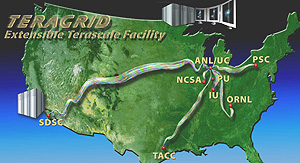University to receive $48 million to operate TeraGrid
By Steve KoppesNews Office
 | |
The National Science Foundation has awarded $48 million to the University over the next five years to operate and expand the TeraGrid, a national-scale system of interconnected computers that scientists and engineers are using to solve some of their most challenging problems.
The NSF has concurrently granted another $100 million to the University, Argonne National Laboratory and seven other institutions to operate and support computational, storage, instrument and visualization resources for the TeraGrid, as well as user support and related services.
TeraGrid is the world’s largest, most comprehensive distributed cyberinfrastructure for open research. Researchers and educators around the country can now access a range of computing resources that will accelerate advances in science and engineering, from disease diagnosis and weather forecasting to the study of drug interactions with cancer cells and aircraft design simulation.
The name “TeraGrid” stems from “tera,” a prefix meaning “trillion.” A terabyte is a trillion bytes, or the digital equivalent of the amount of information that could be printed on the paper made from 50,000 trees.
Charlie Catlett, a Senior Fellow in the Computation Institute, is Director of the TeraGrid Project, a collaborative project between the University and Argonne National Laboratory.
One way that computing power is measured is in teraflops—the total number of mathematical operations that can be done in one second, Catlett said. Currently, the TeraGrid’s power is slightly more than 60 teraflops. If each of the 300 million people in the United States performed one calculation per second, it would take them roughly 55 hours to compute as much as the TeraGrid can compute in one second.
TeraGrid resources at the eight partner sites are interconnected with a dedicated optical network supporting data transfer between TeraGrid sites at 10 to 30 gigabits per second. Today’s most advanced Internet backbones run at 10 gigabits per second.
“TeraGrid integrates some of the nation’s most powerful resources to provide high-capability production services to the scientific community,” Catlett said. “This five-year award is really to take the initial TeraGrid system and deepen and evolve its capabilities while continuing to provide a persistent national infrastructure.”
The TeraGrid first delivered a production system when a coalition of institutions, including Chicago, completed its construction last September. Researchers from Maryland to California already have used the TeraGrid to support research projects as wide-ranging as brain imaging of neurological disorders to simulating the evolution of the universe following the big bang.
Construction of the TeraGrid, more formally called the Extensible Terascale Facility, began in 2001, with a $53 million NSF grant awarded to four partners. New resources were added in the course of the construction project, and today there are eight partners: the University of Chicago-Argonne National Laboratory; the National Center for Supercomputing Applications at the University of Illinois, Urbana-Champaign; the San Diego Supercomputer Center at the University of California, San Diego; the Pittsburgh Supercomputing Center; Oak Ridge National Laboratory in Tennessee; Purdue University in Indiana; Indiana University, Bloomington; and the Texas Advanced Computing Center at the University of Texas, Austin.
“This grant is about enabling science by advancing and evolving the TeraGrid system, which at the moment has about a thousand users,” Catlett said. “We expect to grow that number from seven to 10 times larger.”
Many of these new users will join TeraGrid through 10 science gateways, with funding for the integration of the initial 10 coming from the NSF grant. These gateways will allow more researchers and educators access to the TeraGrid in ways tailored to their special needs through their own desktop computers or through advanced Web portals.
For example, part of the $48 million grant to the University will support the integration of a biomedical genome interpretation project into the TeraGrid. Rick Stevens, Professor in Computer Science and Director of the Mathematical and Computer Science Division at Argonne, will lead that project. Stevens served as project director of TeraGrid during its construction phase, from 2001 to 2004.
The project is called the National Microbial Pathogen Resource Center, which was established in 2004 with an $18 million contract from the National Institute of Allergy and Infectious Diseases.
Today approximately 200 scientists use the center to help accelerate their research into the biology and evolution of deadly microorganisms and develop methods for their control.
For more information about TeraGrid, see http://www.teragrid.org.
![[Chronicle]](/images/sidebar_header_oct06.gif)